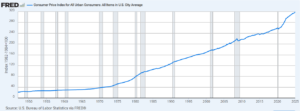Understanding Inflation: A Unique Perspective from Extreme Investor Network
Inflation is a topic that grips the attention of economists and casual readers alike, especially when it hits home on everyday products. Recently, the price of eggs surged by a staggering 15%. Headlines erupted — but is the rush to judgment justified? At Extreme Investor Network, we believe it’s critical to delve deeper and understand the underlying forces at play in this complex economic landscape.
The Limitations of Traditional Analysis
The prevailing narrative is often simplistic: as inflation rises, we need to increase interest rates to combat it. This conventional wisdom overlooks fundamental truths. Take the egg price increase, which is more a reflection of supply chain challenges—specifically avian flu affecting chicken populations—than of rampant economic mismanagement. Raising interest rates won’t magically eradicate bird flu.
In an economic context, inflation should not universally be seen as a nemesis. In fact, inflation can often correlate with economic growth unless it spirals into hyperinflation, a scenario marked by a complete loss of confidence in government and currency. In contrast, deflation signals contraction and economic stagnation. Thus, the question arises: should we truly fear inflation or its implications?
Rethinking Economic Indicators
Rising inflation doesn’t inherently spell doom for the economy. Contrary to popular belief, inflation can coexist with growth, while deflation typically appears during bear markets—where interest rates tend to decrease rather than increase. What today’s analysts often neglect is a nuanced understanding of these variables.
Instead of viewing interest rate hikes as a solution for inflation, understanding the expectation of rising inflation can lead to misguided policy actions from the Federal Reserve, based on speculative fears rather than empirical data. This disconnect is embedded within the framework of Keynesian economics and often leads analysts to overlook the capital flows that are the real drivers of economic dynamics.
The Historical Context of Inflation and Interest Rates
History provides a valuable lens through which we can analyze the current situation. There was a time when a public debate on economic principles could reshape narratives. In the 90s, I was invited to debate economists about GDP and CPE formulas; I emphasized the significance of the statistics’ derivations across different nations. This methodology remains crucial today as many analysts fail to differentiate these variables adequately.
Importantly, interest rates tend to drop during recessions, not soar, as fearfully predicted by the narratives pervasive in current media. Historically, we’ve seen this over decades—rising rates correlate with turbulent economic climates where markets are thriving, not struggling.
Expanding the Discussion Beyond Political Affiliations
In recent events, political narratives have given rise to a blame game regarding inflation—pointing fingers from former President Trump’s tariffs to President Biden’s sanctions on Russia. However, simplistic attributions fail to acknowledge complex interdependencies. Inflation is a multifactorial phenomenon; geopolitical actions, like sanctions, inevitably have ripple effects, influencing global economies.
Sanctions against Russia arguably contributed to inflation, yet such narratives conveniently avoid scrutiny in mainstream discussions. For instance, calling it “Putin’s inflation” distracts from the global chain reactions set off by imposed sanctions, which hurt consumers worldwide.
Economics as a Broader Framework
The dialogue surrounding economics today must transcend biased political lenses and engage with the multifaceted nature of economic drivers. We must look critically at the impact of financial policies on small businesses, consumers, and the broader economy without prejudice. Instead of dismissing economic hardships as mere byproducts of one administration or another, we should consider the long-term implications of policy decisions and their impacts on various segments of the population.
At Extreme Investor Network, we advocate for a holistic understanding of these dynamics. By fostering discussions about capital flows, government policies, and market responses, we can create a more informed view on how inflation truly influences everyday life and investment opportunities.
In conclusion, the economics of inflation and interest rates require not only knowledge but also a willingness to question established norms. Join us at Extreme Investor Network as we uncover deeper insights into the economic shifts influencing our lives and what that means for the future. Understanding these dynamics is not just for economists—it’s essential for investors and everyday consumers alike. Let’s rethink the conversation around inflation together!

